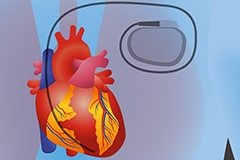The IMPLANTABLES: Super Help for Erratic Hearts
Medically Reviewed by Prabal K. Guha, MD
Pacemakers & Implantable Cardiac Defibrillators
If you’ve ever watched a teenager spend hours playing video games or texting friends while you’re trying to talk with them, you may think, “Technology, what a curse!”
Certainly in the cases just mentioned, it may be true. Yet, technology for heart conditions is literally life saving and is so miniaturized it can be surgically implanted in the patient.
“Pacemakers and the Implantable Cardiac Defibrillators (ICD) use electrical pulses to control hearts that are beating too slowly, too fast or erratically,” says McLeod Electrophysiologist Prabal Guha, MD. “Each device is like a small computer, about the size of a watch face and less than half an inch thick with batteries that can last more than 6 years.”
Both types of devices have wires (leads) that touch the heart muscle. The wires are connected to the “generator”, which has a battery, small computer and a unit to produce the electrical pulse. Each device is designed to help with a different problem.
PACEMAKER
If the heart beats too slowly, the person can feel tired, dizzy or have fainting spells. This condition is called brachycardia.
The pacemaker monitors the heart. If it slows too much, an electrical pulse is sent to the muscles in the heart. The pulse prompts the hearts to beat faster and evenly.
IMPLANTABLE CARDIAC DEFIBRILLATOR (ICD)
The implanted cardiac defibrillator contains a pacemaker, but is also used to control the heart when it beats too fast or erratically. Patients are given ICDs after problems in the lower chambers of the heart (ventricle), such as ventricular arrhythmia, heart attack, sudden cardiac arrest or congestive heart failure.
When the ICD detects a problem, it sends a shock or series of electrical pulses to the heart to stabilize the beat. It’s sort of like having a medical technician standing by with those paddles, ready for whenever you need them.
NOT A CURE
It’s important to understand that these devices help correct or maintain the heart’s beating pattern, but they do not cure the problem that requires their use. They do help the patient regain and retain a much higher quality of life. By keeping a heart beating fast enough to keep fresh blood flowing in the body or by preventing sudden cardiac death, these are truly life-saving technologies.
THE PROCEDURE
To install the device, an electrophysiologist or cardiologist will make a small incision (1-2”) below your collar bone on the left side of your chest. The generator is placed in this pocket.
Wires are threaded through a vein near the collarbone and put in place in the heart.
The patient can be sent home the same day or could be in the hospital for a day or two.
MONITORING
In much the same way the water company can read your meter over a phone line or wirelessly by driving by your house, your physician can monitor your pacemaker or ICD in the office, over the phone or sometime continuously using the Internet.
This capability allows your cardiac specialist to adjust the device to ensure it’s operating most efficiently.
FINAL THOUGHT
With a pacemaker or ICD, the patient should now have enough energy to tell their teenagers to turn off his video game or put her phone away.
Sources include: McLeod Health, National Institutes of Health, American Heart Association, Heart Rhythm Society
-
McLEOD REGIONAL MEDICAL CENTER FLORENCE
843-777-2000 -
McLEOD DARLINGTON
843-777-1100 -
McLEOD DILLON
843-774-4111 -
McLEOD LORIS
843-716-7000 -
McLEOD SEACOAST
843-390-8100 -
McLEOD CHERAW
843-537-7881 -
McLEOD CLARENDON
803-433-3000



-
McLEOD REGIONAL MEDICAL CENTER FLORENCE
843-777-2000 -
McLEOD DARLINGTON
843-777-1100 -
McLEOD DILLON
843-774-4111 -
McLEOD LORIS
843-716-7000 -
McLEOD SEACOAST
843-390-8100 -
McLEOD CHERAW
843-537-7881 -
McLEOD CLARENDON
803-433-3000
 Find a Doctor
Find a Doctor  Locations
Locations  Services
Services 